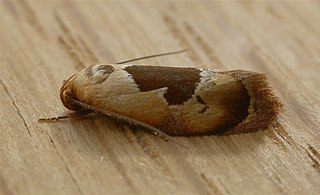| Catacometes hemiscia | |
|---|---|
| Scientific classification | |
| Kingdom: | |
| Phylum: | |
| Class: | |
| Order: | |
| Family: | |
| Genus: | |
| Species: | C. hemiscia |
| Binomial name | |
| Catacometes hemiscia (Meyrick, 1883) | |
| Synonyms | |
| |
Catacometes hemiscia is a moth in the family Oecophoridae. It was described by Meyrick in 1883. [1] It is found in Australia, where it has been recorded from New South Wales. [2]

Moths comprise a group of insects related to butterflies, belonging to the order Lepidoptera. Most lepidopterans are moths, and there are thought to be approximately 160,000 species of moth, many of which have yet to be described. Most species of moth are nocturnal, but there are also crepuscular and diurnal species.

Oecophoridae is a family of small moths in the superfamily Gelechioidea. The phylogeny and systematics of gelechoid moths are still not fully resolved, and the circumscription of the Oecophoridae is strongly affected by this.

Australia, officially the Commonwealth of Australia, is a sovereign country comprising the mainland of the Australian continent, the island of Tasmania, and numerous smaller islands. It is the largest country in Oceania and the world's sixth-largest country by total area. The neighbouring countries are Papua New Guinea, Indonesia, and East Timor to the north; the Solomon Islands and Vanuatu to the north-east; and New Zealand to the south-east. The population of 25 million is highly urbanised and heavily concentrated on the eastern seaboard. Australia's capital is Canberra, and its largest city is Sydney. The country's other major metropolitan areas are Melbourne, Brisbane, Perth, and Adelaide.
The wingspan is about 16 mm. The forewings are white, towards the costa faintly greyish-tinged and with a dark fuscous blotch on the inner margin, extending almost from the base to two-fifth, terminated above by the fold, posteriorly lighter and ill-defined. There is an ill-defined cloudy fuscous subquadrate blotch beyond this, extending on the inner margin from before the middle to three-fourth, reaching rather more than half across the wing. There is also a dark fuscous dot in the disc before the middle, confluent with the anterior angle of this blotch, and a small dark fuscous spot in the disc beyond middle, connected with the posterior edge of the blotch near the inner margin by a curved row of three smaller fuscous spots. There is a dark fuscous ill-defined partially interrupted transverse line from just below the costa at two-third to before the anal angle, angulated outwards in the disc. A straight suffused dark fuscous line is found from the costa a little before the apex to the hindmargin just above the anal angle, beyond which the ground colour is suffused with pale grey, forming a narrow hindmarginal band. The hindwings are whitish-grey, towards the base whitish. [3]

The wingspan of a bird or an airplane is the distance from one wingtip to the other wingtip. For example, the Boeing 777-200 has a wingspan of 60.93 metres, and a wandering albatross caught in 1965 had a wingspan of 3.63 metres, the official record for a living bird. The term wingspan, more technically extent, is also used for other winged animals such as pterosaurs, bats, insects, etc., and other fixed-wing aircraft such as ornithopters. In humans, the term wingspan also refers to the arm span, which is distance between the length from one end of an individual's arms to the other when raised parallel to the ground at shoulder height at a 90º angle. Former professional basketball player Manute Bol stands at 7 ft 7 in (2.31 m) and owns one of the largest wingspans at 8 ft 6 in (2.59 m).

